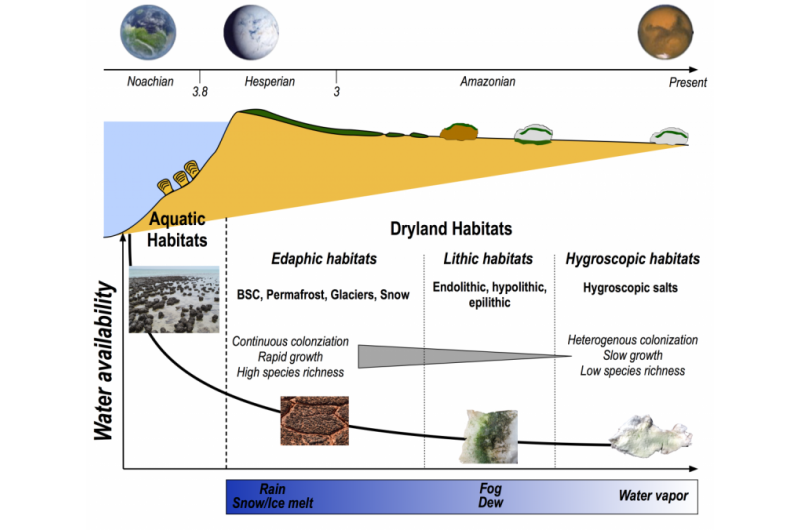Identifying regions on Mars for past life signs

Mars has been a frozen desert for billions of years. Any evidence of life near the surface will likely be fossilized and probably damaged, thus making it very difficult to recognize. If life ever evolved on Mars, there is a real possibility that the last surface ecosystems occupied land habitats, not aquatic ones. Those "last outposts" could contain the best-preserved evidence of past life on the planet.
But how can we recognize them and how can we optimize landing site selection for our probes to maximize the chances of finding proof that Mars hosted living things.
On Earth, research conducted in the driest deserts can shed light on how microorganisms could have adapted and survived when faced with extreme water limitations. This has allowed us to reconstruct the most likely sequence of ecological transitions that would have taken place on Mars as the planet became increasingly colder and drier, eventually leading to the extinction of all life near the surface. Early land communities on Mars would have colonized the top few centimeters of the soil, with metabolic cycles tuned to episodes of rainfall, snow or glacier melt. Pigmentation and community structure would have become adapted to protecting these organisms against ultraviolet light, and proximity to the surface would have provided access to sunlight and an abundant carbon source in the atmosphere.
These communities would have consisted of organisms able to dry up without dying, and resuming metabolic activity quickly after rehydration despite years of drought. Examples on Earth of such organisms can be found in the so-called biological soil crusts that exist in many temperate deserts.
As Mars slowly dried out, these top soil communities would have become discontinuous, being gradually replaced by desert surfaces. At this point, long-term active metabolism would have been constrained to rock inhabiting communities, colonizing the underside or interior of certain rocks. The colonization of rocky formations is a direct response to water deficit. In Mars' deserts, underside and interior habitats of rocks extend the range of conditions under which liquid water can occur.
Surface tensions in rock structure slow the evaporation of water, and this maximizes access to moisture after a wetting event. This protected rock microenvironment also provides shelter against erosion and wind, shielding against ultraviolet radiation, and moderation of extreme temperature fluctuations.
Not surprisingly, colonized rock habitats are found in all of Earth's deserts, including regions once considered to be too dry for life.
Another of the likely last outposts for life on Mars are the interiors of salt crusts, which can trigger the condensation of liquid water at relative humidity conditions well below the atmospheric condensation point. A populated briny solution would have behaved like antifreeze, depressing the freezing point of water. Meanwhile the interior of the salt substrate would have offered shelter against ultraviolet radiation.
On Earth, such microbial communities can be found in salt crusts in the Atacama Desert of northern Chile, considered the driest region on Earth.
Upcoming expeditions to the Red Planet should take these regions into consideration for future landing sites. Being able to land near rocky formations or area of salt crust should heighten the possibility of determining if life once existed on our now cold and dusty neighbor.
Provided by SETI Institute





















